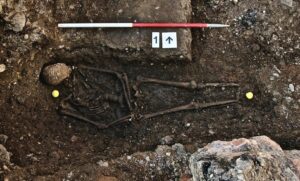
England, August 22, 1485: On a summer morning, two armies approach from opposite directions. Soon they will meet in fields skirted by marsh in the heart of England’s countryside.
The larger army pauses where it commands the higher ground, enjoying an advantage over the still-unseen enemy. Its leader is King Richard III. His opponent is Henry Tudor, a challenger for the throne, backed by an army of French mercenaries and Welsh supporters. Richard knows Henry’s troops will come this way as they head toward London, and Richard’s English soldiers will be waiting to intercept them.
Before setting out after dawn, the king paraded in armor on horseback before the line of his army, 8,000 strong, their banners fluttering in the breeze. He placed the royal crown on his helmet for all to see. It is a solemn ritual to symbolize his right to rule and to remind them of the loyalty they owe him. Richard knows that if he can defeat Henry today, he will destroy the only real threat to his throne.
Henry Tudor’s army appears in the distance. It is much smaller, a little over 2,000 men. Henry is unsure of his chances and remains in the rearguard, the better to escape should things go wrong.
The fighting begins, and the odds are in the king’s favor. Then Richard does something as unexpected as it is bold. He gives up his place on the high ground and personally leads a cavalry charge, skirting the enemy army and galloping straight for Henry himself.
It is all over quickly. Richard is killed, the last English king to die in combat, at the Battle of Bosworth Field. Henry orders Richard’s body to be stripped and draped over a horse and led to the nearest city, where it will be displayed for all to see and believe—Richard is dead, and Henry is now king.
“As for King Richard, he received many mortal wounds and, like a spirited and most courageous prince, fell in the battle on the field and not in flight.” —Crowland Chronicle
This much was known to be true. But how exactly did Richard die? Where was he buried? Most important, were the terrible stories later told about this controversial king an honest portrayal? Historians puzzled over these mysteries for centuries. It was only with modern technologies—from DNA sequencing to forensic science and medical imaging—that the truth could be uncovered and a true portrait of a notorious king vividly painted.
_____________________________

King Richard III on horseback at the Battle of Bosworth. From Doyle, James William Edmund (1864), “Richard III” in A Chronicle of England: B.C. 55-A.D. 1485, London: Longman, Green, Longman, Roberts & Green
_____________________________
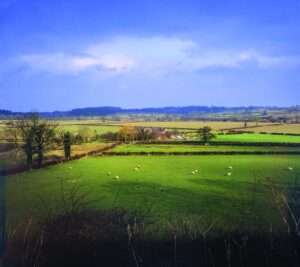
The site of the Battle of Bosworth Field in Leicestershire, England. David Hughes / Shutterstock
_____________________________
“History Is Written by the Victors”
Henry Tudor took the throne as Henry VII, and, little by little, the reputation of the defeated King Richard was destroyed. Chroniclers who had once praised Richard now condemned him. Did they at last feel free, now that he was dead, to tell the truth? Or was there another reason?
Henry VII undoubtedly had a strong motive to ruin Richard’s name. His own claim to the throne was shaky—based on victory in battle rather than bloodlines—and he needed to strengthen it. One powerful way to do that would be to present himself as England’s savior, the king who overthrew a tyrant. Henry cast doubt on Richard’s own right to the throne, claiming that Richard had staged a coup to take the throne from the rightful heir, his nephew Edward.*
_______________________________
*THE PATH TO THE THRONE
Richard III was born in 1452 and was King of England from 1483 to 1485. He was the younger brother of King Edward IV. When Edward died, the king’s 12-year-old son was crowned Edward V. Richard took on the role of lord protector, running the government for the boy, who was too young to rule on his own. That same year, Richard brought forward evidence that his nephew was in fact illegitimate and therefore could not be king. Richard was crowned instead. Edward and his younger brother were sent to live in the Tower of London, and eventually disappeared. It was long rumored, but never proven, that they were murdered by their uncle, the new king.
_______________________________
It has often been said that history is written by the victors. Could this explain what happened in the case of Richard III? Did chroniclers join a smear campaign to win favor with the new regime? If so, it worked extremely well.
With each retelling of his story, Richard became more villainous. He was blamed for more murders and crimes—all, apparently, part of his diabolical plan to seize power. The list of his alleged victims eventually included Henry VI; his brother George; his two nephews; his wife, Anne; and various nobles.
And what about his physical appearance? He had a crooked back, they said, a limp, and a withered arm. A physical deformity, medieval people thought, was a sign of inner evil—or of God’s punishment. The man was obviously a monster!
A century of attacks reached a climax in William Shakespeare’s play King Richard III. His Richard is a hunchbacked schemer without a conscience, who kills for power and delights in his own wickedness.
A few people began to ask: Could Richard really have been so bad? Even his worst enemies had praised his courage in battle, and others agreed that as king he had upheld justice. Yet for the next three centuries, the image of Richard-as-villain stuck, and most historians accepted it. The real Richard seemed to be lost in a tangle of exaggerations, myths, and half-truths.
Even his grave had disappeared.
___________________________
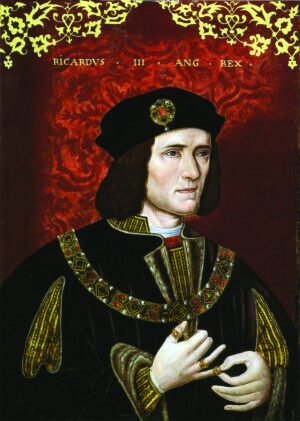
King Richard III. NPG 148 / National Portrait Gallery, from David Williamson, The National Portrait Gallery History of the Kings and Queens of England
___________________________

___________________________
How Do You Lose a King’s Grave?
It is surprising and bizarre—how could the grave of someone as important as a king get lost? Accounts written in the first years after Richard’s death are sketchy, but it seems that for two or three days his corpse was displayed publicly in Leicester, the city nearest the battlefield. This was on Henry’s orders, to prove Richard was dead. Richard was then buried “without any pomp or solemn funeral”—dropped into a hastily dug pit—in the floor of a local church. Two later accounts confirmed this was in the church of the “Greyfriars,” friars who wore gray robes.
In the 1500s, during a period of religious upheaval in England, many churches were destroyed, including the Greyfriars priory. A story began to circulate that, in the turmoil, Richard’s remains had been dug up. An angry mob had carried his body through the streets and dumped it into the river. In the 1600s, historian John Speede wrote that Richard’s now-empty gravesite was in ruins, and his stone coffin had been made into a drinking trough for horses. Most historians accepted this account. There was no evidence to refute it.
In the centuries that followed, new buildings rose over the ruins of old ones, and the medieval city vanished beneath them. And with it disappeared any certainty about where Richard’s final remains might be.
An Ancient Map and a DNA Sequence
In 2004, English historian John Ashdown-Hill took a closer look at Speede’s account of searching for Richard’s grave and the map he had drawn. He discovered that Speede had made a mistake: he had gone to the site of the Blackfriars priory, not the Greyfriars! Could Richard’s remains still lie somewhere under modern Leicester?
At the same time, Ashdown-Hill had been asked to help identify a set of bones buried in a Belgian church. They might be the remains of Richard’s sister Margaret of York. Could he produce a DNA sequence* for Margaret to confirm it was her? To do this, he would need a DNA sample from one of her descendants. First, he would have to trace a family tree, mother to daughter, to a living descendant of Margaret’s. Technology was now available to compare that person’s DNA with the DNA of the skeletal remains and see if they matched.
Margaret’s family tree died out, so Ashdown-Hill tried again with Richard’s older sister Anne. He scoured baptismal registers, census data, and family letters. To his growing amazement, the line kept going, mother to daughter. Richard’s sixteenth grandniece was living in Canada—Joy Ibsen. When Ashdown-Hill contacted Ibsen with the news, she was stunned. She had no idea she was related to the infamous king.
______________________________
*mtDNA
Our cells contain two types of DNA. Nuclear DNA is a fifty-fifty mixture of both parents’ DNA. But mitochondrial DNA (mtDNA) is inherited entirely from the mother unchanged. Richard and his sisters would have had identical mtDNA, inherited from their mother. Yet only his sisters would pass on that mtDNA to their children, and only their daughters could pass it on in turn.
______________________________
Richard had no direct descendants. But Ashdown-Hill realized that just as a mtDNA match with Ibsen could prove that the skeleton in Belgium was Margaret’s, it could also prove the identity of Richard’s remains––if only his lost burial place could be found.
An Eerie Intuition
Philippa Langley, a writer living in Edinburgh, was visiting Leicester in 2004 to get ideas for a screenplay. She believed history had been unfair to Richard III and that his life would make a dramatic movie. Maybe walking the streets of the city he visited before his final battle would provide inspiration.
Langley headed to a parking lot on New Street. A portion of a ruined medieval wall in the modern car park had prompted rumors that the Greyfriars church might have once stood there. She walked past the cars to the stone wall, but nothing seemed helpful to her quest. As she exited, she noticed another parking lot across the street, behind gates and a “Private” sign. Curious, she slipped through and walked across the lot toward a red brick wall at the other end.
As she neared the wall she felt the oddest sensation: “My heart was pounding . . . I had goose bumps, so much so that even in the sunshine I felt cold to my bones. And I knew in my innermost being that Richard’s body lay here. Moreover I was certain that I was standing right on top of his grave.” But would anyone believe her?
A Million to One
Five years later, Langley invited Ashdown-Hill to Edinburgh to give a talk to the local Richard III Society, a group that shared their keen interest in the king. She told him about her instinct; he explained his research. He believed he knew where the Greyfriars church had been located: it must be at the northern end of the parking lot where she had stood. Langley made a decision. With the help of the Richard III Society, she was going to search for the king’s grave!
Many people scoffed at the idea that a king was lying forgotten underneath a modern parking lot, but Langley was determined. Like Ashdown-Hill, who guessed that clues to the truth might lie in the king’s DNA, Langley hoped finding a body would “bring to light the real Richard.”
Langley convinced the city council to permit a dig in the parking lot, then met with archaeologist Richard Buckley from the University of Leicester. He was intrigued by the idea of finding the lost Greyfriars church. It might reveal new insights about medieval Leicester and life 500 years ago. They struck a bargain: Buckley’s team would search for the church; Langley would keep her fingers crossed that the excavation would also turn up a grave.
Buckley guessed the chances of finding the church were about fifty-fifty. The grave of the king, however, was beyond a long shot. “A million to one,” he joked.
Tearing Up the Tarmac
In August 2012, Buckley’s team prepared to break ground. The excavating machine roared into action. Its driver swung the mechanical arm with its clawlike scoop, which began to chew up the tarmac of the first trench. To everyone’s disappointment, the first bits of stonework they found turned out to be the remains of a Victorian outhouse.
Matthew Morris, the site director, suddenly raised his hand in the air, and the roar of the excavator stopped. About 1.5 m (5 feet) down, a long bone was visible in the soil. It looked like a leg bone. Using a trowel, Morris gently removed the earth around it. Slowly, a second bone came into view, lying parallel to the first. It looked like two legs, side by side. Could it be part of a skeleton?
Morris reminded Langley not to jump to conclusions. These could be from any century and might belong to anyone. So far they hadn’t found a scrap of medieval stonework that might locate the church. In any case, they could not disturb the bones until they had applied for a license to exhume human remains for archaeological purposes.
As the dig progressed, bit by bit, evidence of a medieval building came to light—decorated tile and stained glass. Several days into the dig, the team uncovered unmistakable evidence of church walls and graves. It was enough to convince Buckley to apply for a license to exhume the human remains.
______________________________________
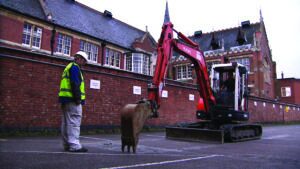
Above and below: Archaeologists uncover clues as they excavate the parking lot. University of Leicester
______________________________
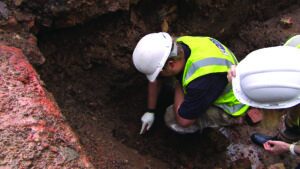
______________________________

Map of the excavation, with three trenches cut across the parking lot. University of Leicester
______________________________
Bringing the Bones to Light
Team members prepared to uncover whatever lay alongside the leg bones. They donned forensic suits that covered them from head to foot, to avoid contaminating the bones by shedding their own DNA, and stepped gingerly into the trench. Jo Appleby, an osteologist (an archaeologist specializing in human bones), worked with a mattock, an ax-like tool with a broad blade, to chip her way down and look for any more skeletal remains.
It was indeed a human skeleton. The feet were missing—probably cut off when a wall was laid in the 1800s. Other construction had missed the head by millimeters. Possibly this was a friar, buried in the church?
Appleby next uncovered something startling. The skeleton’s skull was raised and leaning forward toward the chest, and the spine clearly curved to one side, like a C. Langley was shocked. It couldn’t be; she had felt sure that if they found Richard, his spine would be straight, disproving the hostile descriptions. Maybe this wasn’t Richard at all. But if it was . . . did that mean the stories about his physical deformities were really true?
The team filmed and photographed the skeleton where it lay. Then each bone was carefully removed and placed in a clear plastic “finds bag.” Altogether they fit in a cardboard box. The archaeologists remained cautiously neutral about the identity of the remains. But Langley and Ashdown-Hill felt differently. They had brought a replica of Richard III’s royal banner, which they draped over the box before Ashdown-Hill carried it to the waiting van.
____________________________

The skeleton discovered in the first trench. University of Leicester
____________________________
A Case for Forensic Science
The van headed to the University of Leicester. There, a team of experts would analyze the skeleton from different angles. Their approach would be like fitting together the pieces of a puzzle. The bones were treated like a modern forensic case—what would they reveal about the individual, how he died, and possibly who he was?
The first step was to conduct a CT scan of the bones. The scientists could now see inside each bone, without cutting anything open. As part of this process, digital images from the CT scan were used with a 3-D printer to create a model of the skeleton. The model skull was so precisely lifelike that even growth rings could be seen!
Meanwhile, the bones were subjected to carbon-14 dating*, to get a rough idea of their age. Two samples from rib bones were sent to different labs to cross-check the results.
The outcome was a disappointing setback. It was 95 percent probable that this person had died between 1430 and 1460. But Richard III was killed in 1485. It looked as though the skeleton might be too old to be his.
___________________________
*NARROWING THE RANGE
Radiocarbon dating cannot pinpoint an exact date, it can only estimate a range of dates along with a percentage of accuracy. Two results are usually given. The first indicates a 68 percent chance that the correct age lies within a span of years; the accuracy increases to 95 percent when the range of years is doubled.
___________________________
Then new information added a twist. Other isotopes (different versions of the same chemical element) in the bones revealed details about the person’s diet. This man had eaten a lot of seafood. Marine organisms absorb large amounts of carbon-14, so all the seafood he had eaten likely threw off the test. The result was corrected, and now the date of death was 95 percent probable to have been between 1430 and 1530.
Further isotope analysis revealed more clues. Isotopes in teeth formed in childhood and the early teens retain signs of water and food grown in different regions, showing where a person lived while growing up. These matched what was known of Richard’s early years—he and his siblings had moved around, often on the run from their family’s enemies. It was also clear that in the last few years, this person’s diet had changed drastically. He’d begun to eat lots of expensive meat, fish, and fowl—a diet of banquets, fit for a king!
Richard the Monster?
From the skull, Appleby concluded that this was a man in his late twenties to late thirties (Richard died at 32). A closer look also revealed that he did not have kyphosis, the condition once called “hunchback.” The position of the skull, shoved forward onto the chest, had misled her into thinking the back was hunched, but now it was clear this was just because the body had been dropped into a grave that was too short.
The upper spine was, however, curved sideways. Its owner had had another condition: scoliosis. The 3-D model of the spine was studied by Piers Mitchell, a scoliosis expert. Scoliosis would not cause a hunch, but the twisting shape of the spine would make the right shoulder slightly higher than the left. This would not have been visible when the person was dressed, and he would have been capable of regular physical activity. The leg bones were normal, so he would not have walked with a limp.
Appleby confirmed that there was no withered arm. Both arms were normal. Whoever he was, he had probably been 1.7 m (5 feet, 8 inches) tall, about average for the Middle Ages.
If this was Richard III, the bones proved that the stories about his hunchback, limp, and withered arm were deliberate exaggerations and distortions of the truth.
The Final Blow
The next challenge was to determine the cause of death. Appleby was joined by a forensic pathologist and a trauma expert who worked on modern murder cases to identify the source of cut marks in human bone. Robert Woosnam-Savage also joined the examination. As curator of armor and weapons at the Royal Armouries Museum, he was familiar with medieval battle injuries and the weapons that inflicted them. Together they looked at each bone for the slashes of sword wounds or the deeper V-shaped stab marks of daggers.
There was no doubt this man had died a violent death. The skull bones had damage from multiple attacks using different weapons. Two of these blows could have been fatal and were likely made by a halberd (a weapon with an ax blade and spike on top of a wooden shaft)*. This confirmed one account written shortly after Richard’s death: “One of the Welshmen then came after him, and struck him dead with a halberd.” No battle injuries were found on the body, which must have been well protected by armor. Unusually, the face had been left mostly unharmed. It looked like this victim’s attackers had wanted him to remain recognizable after death. Henry Tudor had indeed displayed Richard’s body so there would be no doubt that the former king was dead.
_____________________________
*Fatal Contest
In 2010, the true site of the Battle of Bosworth Field was finally located on the edge of a marsh by archaeologists. Piecing together clues from the battleground with the forensic results from the skeleton, it was at last possible to reconstruct Richard’s final minutes.
After Richard’s cavalry charge was warded off by Henry’s soldiers, armed with pikes, Richard’s horse probably lost its footing in the marshy ground, and he was thrown off. Now he was vulnerable in the midst of his enemies, who surrounded him. His helmet was torn away, and his opponents rained blows on his unprotected head. He defended himself vigorously to the end, which came quickly.
_____________________________

Battleaxe: The final blow axe (illustration). markgoddard / iStockphtot
___________________________
Facial Reconstruction: The Science of Recreating a Human Face
There are several portraits of Richard III, but these are artists’ impressions. Now there was a chance to accurately recreate the face of the king. The science of facial reconstruction, working from a skull outward, has become a proven method of identifying remains in forensic investigations—from murder cases to disaster victims.
A skull is as unique as a face, but we cannot recognize it until the overlying muscles and tissues are added. Digital technology has made the process faster and more accurate. Caroline Wilkinson, an anthropologist and professor of craniofacial identification, worked with high-res photos and 3-D CT scans of the skull. As the image of the skull rotated on her monitor, Wilkinson added eyeballs and tissue. Using a haptic arm—a device that translates the movements of her right arm and hand into on-screen changes—she was able to model the skull like a sculptor working with clay.
A life-size 3-D printout of the head was given to a digital artist, who added hair, skin, and eye color. The finished face took Langley by surprise: “It was the face of a young man who looked as if he were about to speak, and to smile. I searched in vain for the tyrant. I can’t describe the joy I felt. I was face to face with the real Richard III.”
___________________________
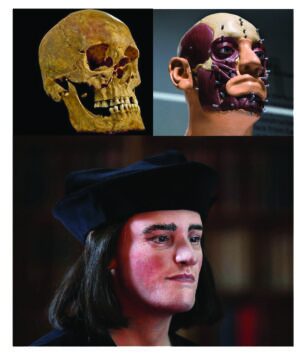
The face of the king: facial reconstruction of Richard III. University of Leicester
___________________________
DNA: The Last Puzzle Piece
It was time to proceed with a DNA comparison to a living descendant of Richard’s sister. Ibsen’s son Michael lived in London, where he worked as a cabinetmaker, and he had agreed to give a live DNA sample, taken at the parking-lot dig itself. The DNA evidence would be the most essential piece to clinch the identification.
Ancient DNA is delicate. Teeth are often the best-preserved parts of a skeleton, and the femur is thick, so samples were taken from each of these. If both samples yielded the same results, it would help to rule out the possibility that the DNA had been contaminated. The DNA sequencing was carried out by two specialist ancient-DNA labs to cross-check the results.
Ibsen’s DNA was then compared to the skeleton’s DNA sequence produced by both labs. Both yielded the same result: a perfect match! All the evidence was next subjected to a statistical analysis. The probability that the skeleton belonged to Richard III lay between 99.9994 and 99.9999 percent.
The team of archaeologists and scientists made their announcement to the world at a press conference. After the experts went through the evidence, Buckley declared that “beyond reasonable doubt, the individual exhumed at Greyfriars in September 2012 is indeed Richard III, the last Plantagenet king of England.”
The Return of the King
In 2015, King Richard III was reinterred in Leicester Cathedral, in a coffin made by his seventeenth-generation nephew Michael Ibsen. Langley was satisfied that one of her crucial goals had been accomplished: an honorable reburial for Richard in the royal tomb that Henry VII had denied him.
Langley’s far-fetched hunch had paid off. The archaeologists pointed out that this was an amazing find, not just because Richard was a king, but because finding a named individual 500 years old, along with the opportunity to analyze the remains, is “extraordinarily rare.” By applying analysis from every relevant stream of knowledge—genetics, medicine, forensics, genealogy, history, and archaeology—the researchers were able to look in incredible detail at the life of a king from the vanished Middle Ages. His life and times—how and where he grew up, what he ate and drank, the wounds that killed him—were all brought to light.
_________________________
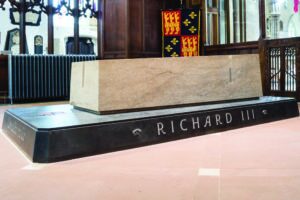
A royal tomb for Richard III in Leicester Cathedral. Jacek Wojnarowski / Shutterstock
_________________________
What We Thought We Knew . . . and What We Know Now
So, was Richard a good king whose reign was cut short by treason, or a deposed tyrant? The evidence of the bones helped to strike a balance between the two extremes: by confirming what grains of truth lay in the confusion of accounts, a reputation was restored and a caricature turned back into a recognizable human being.
Perhaps the last king of England’s Middle Ages was a man of his stormy times, a capable person in whom ambition and a sense of duty coexisted. The truths about his character and his intentions are still left for historians to puzzle over.
The search for King Richard III has taught us that in looking for the truth about a person, science can be applied not just to a skeleton but to history as well. What history has long told us about Richard was held up to the same kind of scientific test as the bones. Legend and fact were separated—the king was not a monster, his body was never thrown in the river, and his coffin was not turned into a horse trough. If these parts of the historical record were untrue, what else might be? The discovery of the lost king is a powerful reminder to view historical “facts” with an open and objective mind.
____________________________________
From Digging Deep: How Science Unearths Puzzles from the Past © 2019 Laura Scandiffio, published by Annick Press Ltd. All rights reserved. Reproduced with permission.
Digging Deep: How Science Unearths Puzzles From the Past by Laura Scandiffio, shows archaeological discoveries that have made scientific advancements and are now brought to light. From the timeline of the northwest passage to the Kmhere empire, this book is a great STEM resource for those interested in ancient and modern history and those who want to know the science behind such discoveries. More information about purchasing and ordering this book can be obtained at the Annick Press website.




